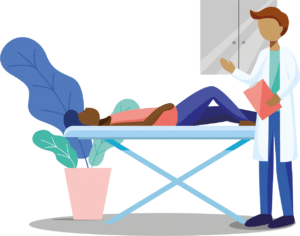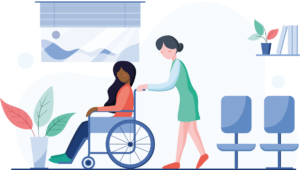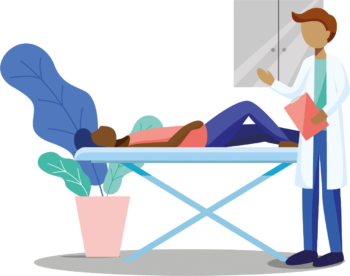Chronic pain impacts an estimated 20% of Americans, but it disproportionately affects certain groups, including older adults, women, veterans, adults living in poverty, and people in non-metropolitan areas, among others.1 This is an example of health disparity, a growing concern among chiropractors and other healthcare professions. In honor of National Chiropractic Health Month this October, the Healthy Living Blog talks to chiropractors about the challenges of members of historically underserved communities who experience chronic pain.
The Centers for Disease Control and Prevention (CDC) define health disparities as “preventable differences in the burden of disease, injury, violence, or opportunities to achieve optimal health that are experienced by socially disadvantaged populations.”2 These populations can be defined by race, gender, sexuality, income, disability or other factors, and their experiences can directly impact the way they receive health care.
“These differences can lead to devastating statistics such as the birth mortality rate between white and black babies, the differences in life expectancy between indigenous and black populations compared to white populations, and the lack of health coverage for specifically black, Asian, and indigenous populations,” says Maithy Ta, DC, a member of ACA’s Board of Governors who practices in Kansas City, Mo., with a wide range of patients.
 Health disparities can present in different ways depending on the patient, their identity and their experiences. Bias and discrimination contribute to disparities for people of color and LGBTQ+ people, among others. Lack of access to health care and adequate communication with providers are disparities that impact many people, including those in low-income populations. The link between higher levels of mental health disorders and a prevalence of chronic pain among some populations also may impact the way they receive care.
Health disparities can present in different ways depending on the patient, their identity and their experiences. Bias and discrimination contribute to disparities for people of color and LGBTQ+ people, among others. Lack of access to health care and adequate communication with providers are disparities that impact many people, including those in low-income populations. The link between higher levels of mental health disorders and a prevalence of chronic pain among some populations also may impact the way they receive care.
Chronic Pain: Complex and External Factors
Chronic pain can be especially complicated for populations experiencing health disparities, as pain can often be impacted by other external factors. “Chronic pain is multi-faceted,” Dr. Ta explains. “As we look at not just the physical causes, but the mental, emotional, and social aspects that can all help shape a personal experience, we begin to realize how the pain experience is much more complicated than the symptom itself. By having poorer access to care, whether that’s due to geographic location, insurance coverage, physician shortages, language, or cultural barriers, chronic pain becomes almost inherent for demographics and populations that face these health disparities, because they don’t have the resources to combat the pain or take care of themselves.”
LaKia Brown, DC, CCSP, of Merrillville, Ind., an ACA member who is active on the association’s Committee on Equity, Diversity and Inclusion (CEDI), adds, “Those populations will experience higher rates of illness, injury and death across a wide range of health conditions.”

Dr. Brown reiterates that while everyone should receive the same high quality health care, people in socially disadvantaged populations who experience chronic pain face additional barriers to care. “The first one would be convincing doctors that their pain is real,” she says. “The implicit biases of healthcare providers can contribute to the differences in chronic pain intervention to certain cohorts of people such as [people of color] and women.”
Logistical Obstacles to Care
Another challenge related to chronic pain intervention is the ability to access care in the first place. Dr. Brown explains that things such as health insurance coverage, the affordability of health care, having access to transportation to and from healthcare facilities, and language barriers can all contribute to a patient’s difficulty accessing care. “[You have] geographic barriers, lack of transportation, and then a shortage of doctors who treat chronic pain,” she said.
Dr. Ta adds that the issue of access goes beyond accessing health care itself. “[There is] a lack of great resources that meet the patient where they are,” she says. “Whether it’s the financial responsibilities they have, or the needs for their children, or the limitations of the education they received, it’s important to note that sometimes, the choice to live a healthier lifestyle is not in the cards for certain individuals. Many communities don’t have the options or materials readily available, so even in times that the patient may be looking to make a healthy change, they don’t have the know how or a good starting point to begin.”
Evidence Supports a New Approach
While many patients with common musculoskeletal conditions such as back pain and neck pain might turn to over-the-counter and prescription pain medications (such as opioids) for pain relief, research today supports the use of nonpharmacologic (non-drug) approaches as beneficial, safer options to try first. In its 2022 Clinical Practice Guideline for Prescribing Opioids, the CDC promotes “diverse approaches and varied pain management solutions” and specifically encourages use of non-opioid/nonpharmacologic therapies as a first line of treatment against subacute and chronic pain.3
“Chiropractors are in the unique position that we are the experts on musculoskeletal complaints, and in addition to that, we are portal of entry, meaning a patient does not need a referral to see us as providers,” Dr. Ta says. “As a chiropractor identifies the needs of a patient and the stressors that have caused them chronic pain, whether it be physical or not, we can create a truly collaborative and integrative model to help begin eliminating these barriers to care and develop a strong team-based approach to how we look at chronic pain and health disparities.”

Nevertheless, access to non-drug therapies such as chiropractic services sometimes may be limited due to availability and insurance coverage. “Nonpharmaceutical services such as acupuncture, chiropractic and massage do help with chronic pain, but often they are inconsistently covered by health insurance, or the health insurance does not cover them at all,” Dr. Brown says. “When they’re not covered at all, that makes those services only available to those who can afford to pay out of pocket, so now we’re leaving a certain population out in left field.”
Efforts to Improve Access
The American Chiropractic Association is working to pass legislation to increase Medicare coverage of chiropractic services. In addition to helping seniors and other beneficiaries gain improved coverage of chiropractic services, a change in Medicare coverage of chiropractic could have an impact on private and state health plans, as Medicare’s coverage often serves as a template for others. The Chiropractic Medicare Coverage Modernization Act (H.R. 1610/S.799) would improve Medicare beneficiaries’ access to the chiropractic profession’s broad-based, non-drug approach to pain management. (Learn more about Medicare modernization and find out how you can help.)
In respect to raising awareness of the challenges encountered by historically underserved communities, ACA and the CEDI have hosted several educational courses and roundtables about health disparities for ACA members. According to Dr. Brown, these sessions help increase cultural competency among chiropractors and serve as a tool to better educate doctors on implicit bias.
Additional Resources
Following are resources for those facing health disparities or barriers to health care:
- Whether Medicaid covers chiropractic depends on what state you live in. Find contact information to your state Medicaid program here. (Note: A 2018 chart assembled by the Kaiser Family Foundation provides some idea of which states might offer chiropractic today.)
- Chiropractic colleges often have clinics that will provide care to community members for a discounted rate.
- Some community health centers offer chiropractic care. Find a community health center in your area through the National Association of Community Health Centers, which works in support of the expansion of healthcare access for the medically underserved and uninsured.
- The Veterans Administration provides access to chiropractic services at multiple VA facilities across the country.
- Read more about health disparities and chiropractic.
- It may also be beneficial for people experiencing lack of access to chiropractic care to speak directly with a private practice about things such as discounts for cash payments, financial hardship plans or other payment plans that can potentially help make care more affordable. Find a chiropractor near you.
For more information on prevention and wellness, or to find a doctor of chiropractic near you, visit handsdownbetter.org.
References
- Rikard SM, Strahan AE, Schmit KM, Guy GP Jr.. Chronic Pain Among Adults — United States, 2019–2021. MMWR Morb Mortal Wkly Rep 2023;72:379–385. DOI: http://dx.doi.org/10.15585/mmwr.mm7215a1.
- CDC https://www.cdc.gov/healthyyouth/disparities/index.htm
- Dowell D, Ragan KR, Jones CM, Baldwin GT, Chou R. CDC Clinical Practice Guideline for Prescribing Opioids for Pain — United States, 2022. MMWR Recomm Rep 2022;71(No. RR-3):1–95. DOI: http://dx.doi.org/10.15585/mmwr.rr7103a1.



